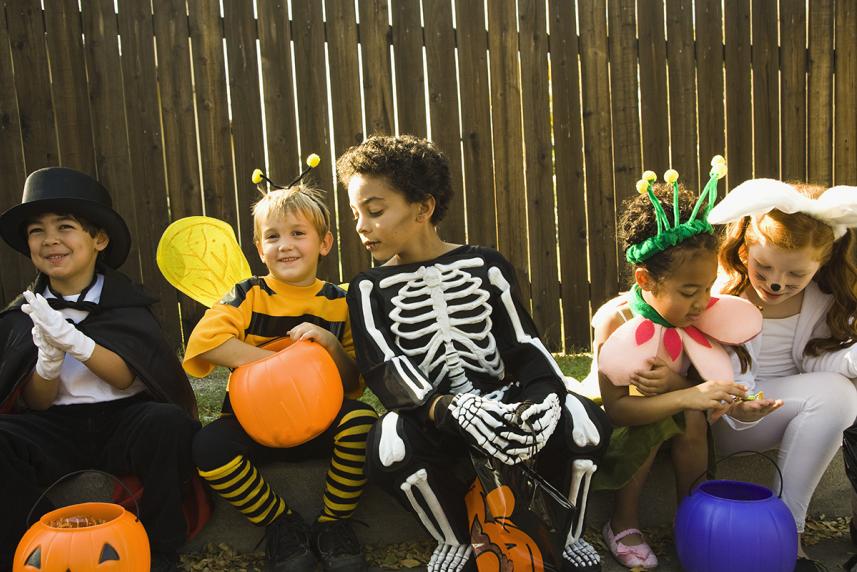
We carry a range of HSA- and FSA-eligible products, including over-the-counter medications, medical devices and more. And you can have it all delivered to your door.

It’s almost time for kids to go trick-or-treating. Here’s how to make sure your little ghosts and goblins have a safe, fun holiday.
Halloween is almost here, and your kids are beyond excited. Are they headed to a school trick-or-treat event? Is your whole family dressing up for a neighborhood party? You probably have fun plans. And it’s smart to be prepared for any health mishaps.
We asked experts to share their top strategies to keep your kids safe when they dress up this Halloween.
Does your child’s costume include a mask? “Masks with eye holes aren’t recommended because they can impair vision,” says Leah Alexander, MD. She’s a pediatrician with Mom Loves Best in Fair Lawn, New Jersey.
If kids can’t see well, they can’t safely cross the street. They can also trip on stairs or sidewalks. Consider face paint instead (see tips below).
Other costume pieces can cause kids to trip when they’re out and about. Avoid:
Makeup and face paint can make your child’s costume come alive. But they can also irritate the skin and eyes. Some products even contain harmful ingredients.
Keep your little bumble bee or rock star safe by checking the product label. Steer clear of paints or markers that list potentially harmful ingredients. Some examples: mercury, lead, cadmium and nickel. Once you find a safe product, test a small amount on your child’s arm, says the American Academy of Pediatrics (AAP). Do this a few days before Halloween to see if they’re allergic.
“Costume fabrics can also cause skin irritation and reactions,” says Daniel Ganjian, MD. He’s a pediatrician at Providence Saint John’s Health Center in Santa Monica, California. “Have your child wear a lightweight tee and pair of pants under their costume to stop any discomfort.”
Stock up on medicine and first-aid essentials for your kids at the Optum Store. Get started.
Decorate your child’s costume and trick-or-treat bag with reflective tape or stickers so they’re more visible after dark, recommends Safe Kids Worldwide. Choose a light-colored costume as well.
You and your child should also carry flashlights. This will help you walk down streets and sidewalks more safely. It will also make it easier for drivers to see you.
“Kids under the age of 12 should always have an adult accompany them while trick-or-treating,” says Dr. Alexander. Older kids can trick-or-treat with a group of friends. But be sure to plan and review their route with them.
Agree on a time when your teen or tween should return home. And remind them of these safety tips:
Have your kids carry a cell phone. That way they can get in touch with you if they need help or get separated from their group. Remind them that they can also call 911 in an emergency.
Bring along your child’s rescue medication (such as an EpiPen or asthma inhaler) in case they have an allergic reaction or asthma attack while trick-or-treating, says Dr. Alexander.
What if your child is going to a Halloween party? Or joining a trick-or-treating group with another parent? Be sure that the supervising adult knows how to use the rescue medication. Let that parent know about any allergies or health conditions, too. Make sure they have your phone number so they can get in touch with you quickly.
It’s a good idea to check your child’s treats once they get home. Throw out any candy with torn packages and homemade treats that weren’t made by someone you know. Also, take hard candy, gum and other choking hazards away from young children.
If your child has food allergies, pull out anything that can cause an allergic reaction. Replace those items with candy your child can safely eat.
“I get a lot of phone calls from parents after Halloween because their kids are vomiting from eating so much candy,” Dr. Ganjian says.
Want to prevent candy-induced stomachaches? Limit how much your child eats. The ideal amount depends on your child’s age, but 2 or 3 pieces should do. Since candy sizes vary, check that the candy serving is roughly half the size of your child’s palm.
Store your child’s candy out of reach. Bring it out once or twice a week until it’s gone.
If your child has a stomachache, encourage them to drink plenty of fluids to help move things along, adds Dr. Alexander. Over-the-counter (OTC) anti-gas tablets can help them feel better. But avoid antacids and laxatives. Always call your pediatrician if you’re concerned.

We carry a range of HSA- and FSA-eligible products, including over-the-counter medications, medical devices and more. And you can have it all delivered to your door.
Additional sources
Visibility: Safe Kids Worldwide (n.d.). “Halloween safety”
Face paint: American Academy of Pediatrics (2021). “Face paints & makeup: Choose carefully to avoid toxic ingredients”
Sorting candy: American Academy of Pediatrics (2021). “Halloween Health and Safety Tips”